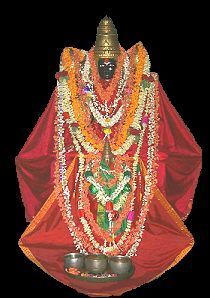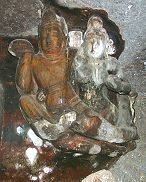 |
HinduismI knew relatively little about Hinduism when we started our trip, and after five weeks of experience I found the philosophy and mythology to be reasonably easy to grasp but I still have difficulty understanding the structure and rituals of Hinduism, and what it means to its practitioners. This is partly because most people when asked about these things found it difficult to answer, perhaps they did not understand the questions. On the other hand the atmosphere generated by Hindu sites has a particularly strong psychological impact. |
|
|
Our first contact with Hinduism was in Nepal at Bhudanilkantha. A 5-metre long statue of Vishnu as Narayan rests in the coils of the 11-headed cobra Annanta in the centre of a shallow basin of red water. The impression created is of a dead figure carried away on a sea of blood, though actually the scene represents the creation of the universe. Pilgrims chatter noisily while circumambulating the pool and scattering flower petals and red powder into the water and onto the statue. The petals float in the water and are strewn on the exposed parts of the body. As in many religious places, there is a sweet smell of incense, contrasting with the acrid smoke of burning oil. When we visited it was one of those warm wet days when the surrounding buildings disappear into mist and rain, creating a larger watery environment so that you really could imagine that you were seeing Vishnu in the primaeval ocean. The name of the goddess incarnated in the Kumari of Katmandu varies, but the beginning and end of her investiture are marked by bloodshed. Little girls no older than 6 take part in the terrifying selection process, some guides claim that they must spend the whole night with a corpse, then watch the slaying of numerous sacrificial animals, others that the children are surrounded by decapitated buffalo heads, while masked men try to frighten them. The goddess can be recognised by the fact that she remains impassive throughout these ceremonies. She spends her childhood in a beautiful house in Kathmandu's Durbar square, the woodwork of which is all carved with human skulls and demonesses. She must be looked after very carefully, as her term will come to an end if any of her own blood is shed, even through a tiny scratch or injury. If this is avoided she will cease to be a goddess at puberty, and will receive a large dowry as her golden handshake. The girls chosen to be Kumari are always exceptionally beautiful but despite her beauty and wealth, marriage with the ex-goddess is believed to bring premature death and she often ends up single. Swayambunath near Katmandu is mainly a Buddhist complex which includes several Hindu places of worship. After seeing the stupa I wandered over to the Hindu temple just behind it. This building is so small and decorated it looks almost like a child's play house and has just enough space for a few people to stand in front of the god. There are so many people crowded into the tiny courtyard around the temple that it is quite hard to tell what is going on. The pilgrims gather around two men seated on the ground which is liberally covered with flower petals and religious paraphernalia. They are occupied with chanting and pouring holy water on people's hands as they approach the temple. People are pushing and shoving to get inside the building but it is impossible to tell which god they are so keen to visit. As we were leaving Swayambunath, I was drawn to another temple standing to one side of the little square. Unlike most Hindu temples it was empty and completely dark inside, not just from the absence of light, the walls and floor gave the impression of being completely black. The only break was right opposite the entrance where there was a little gold door and above it some painted eyes. They were not colourful and stylised like the eyes of Buddha on the stupa, but more like the eyes on Roman portraits and they seemed both enticing and menacing. The guide explained that this temple contains a natural tunnel accessible only to the priests and is the site of a mythical tunnel which is supposed to go deep into the earth, to the lands of eternal fire. The temple is associated with Tantrism. |
||
|
Painted carving at Ellora 
|
||